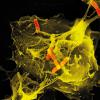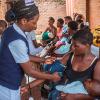Martin Mintchev tells Sarah Campbell about the e-mosquito – which has been in development for 10 years and is hoped to help people monitor their type 1 diabetes.

For many people with type 1 diabetes, one important way of managing their condition is to carry out regular blood glucose tests. This involves pricking a finger, drawing blood, dabbing the blood on to a testing strip and recording the results several times a day. Ask a person with diabetes how they feel about doing this, and most will say that it’s a pain, but it helps them to stay in control of their condition.
Martin Mintchev at the University of Calgary in Canada has been working on something that could eventually make life much easier for people with type 1 diabetes: a wearable device that “bites” the patient at intervals to take blood samples.
It has earned the nickname the “e-mosquito” for obvious reasons, and Martin and his colleagues have recently produced a prototype that proves the concept. It is a lightweight, cheap machine worn on the wrist that penetrates the skin and finds a capillary almost painlessly.
This device is something of a labour of love for Martin. It’s already been 10 years in the making, and there’s still much work to be done on it before it can be commercialised. “When we started out, the only actuator that we could think of that was capable of driving a needle to penetrate the skin was a piezoelectric actuator, which requires huge electric power and a huge surface area,” he says. “So our initial prototype, which was publicised in 2009, was the size of a deck of cards. And it was prohibitively expensive. The piezoelectric actuators alone cost at least $500 each.”
Then, in the early 2010s, a new type of actuator mechanism came on to the market: shape memory alloy – an alloy that contracts or expands depending on the current passed through it.
Once Martin and his colleagues started using this new alloy as the driver for the needles, they realised they could dramatically reduce the size and cost of the device. “Conceptually, we came to the point at which, with a small wearable device, we can mimic a mosquito bite beautifully.
“We reach a capillary 100% of the time and do so almost completely painlessly, particularly if the person is not aware that a bite will occur during the day. As you go about your routine work, you will never notice if you have been bitten by the device,” Martin says.
However, the accuracy with which the device mimics nature has caused something of a stumbling block for the team. Think about the last time you were bitten by a mosquito. Did any blood appear on your skin once the insect had flown off? Probably not. And this is a problem.
“Our initial idea was to move a standard testing strip very close to the biting needle in the hope that the blood sample would appear on the surface of the skin and make its way to the strip. And thus we thought that the commercialisation of the device would be relatively easy. From the moment the blood drop became available, the testing method would be standard, so the regulatory hurdle for such an autonomous device would be minimal,” Martin says.
All about Martin
- Professor of electrical and computer engineering in the Schulich School of Engineering, University of Calgary
- 162 published papers
- Studied electronic engineering at the Technical University of Sofia, Bulgaria. Graduated at the same time as the Iron Curtain lifted and took the opportunity to travel, initially to London in 1990
- Moved to Canada in 1991 to do a PhD at the University of Alberta, Edmonton, where he pursued an interest in biomedical electronic systems
- Did a post-doc in experimental surgery before moving to the University of Calgary in 1997
- Now divides time between biomedical engineering and oil field systems projects.
However, despite the device reaching a capillary every time it bites, a blood sample doesn’t usually appear. “Diabetics know this very well,” says Martin. “Even after they finger-prick, they often have to squeeze the finger for a blood drop to appear. We were facing the same issue.”
Martin and his team had a choice: find a way of making blood appear on the skin by increasing the wound size and perhaps using an additional actuator to squeeze the site. Or change the device’s design and deposit a sensor on the biting needle that will do the testing in situ, once the needle reaches the capillary.
They have decided that the latter is the right approach, despite the additional research and development required and regulatory process to get through. “The technology is there, but there’s a lot of logistics and testing involved to make it viable,” Martin says. “The regulatory hurdle becomes all of a sudden a bit higher because now you have a new mechanism with direct contact with the blood in situ. And, of course, the industrial investment for the device to be commercialised becomes significantly higher.”
However, he is not perturbed by this. In fact, he thinks that a marketable device should be possible in the next two to three years. “The biggest hurdle by
far was the actuators,” Martin says. “To be able to reach a capillary with an external biting device 100% of the time is a significant achievement, particularly since the device is miniature, wearable, light and cheap. Now it’s a case of the right collaboration. The sensors we need to test the blood are available, and getting smaller and better over time. Simply, the development cycle needs to be carefully nurtured.”
As is the case with many scientists, Martin also has one eye on the far future. “I work depending on what I perceive to be important societally and what interests me research-wise. Eventually, I want to create a device that is a real-time blood sampler for frequent blood testing at home,” he says. “I think that with our ageing population this will be a very significant step towards allowing more people to be cared for at home.”




